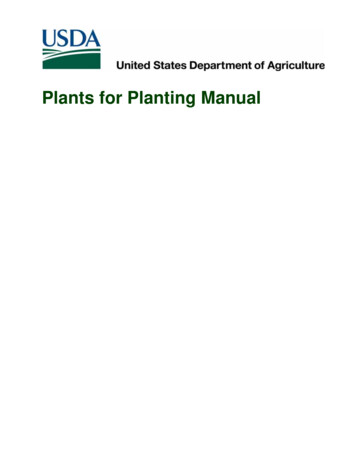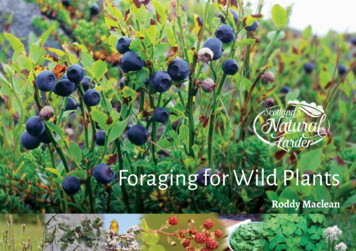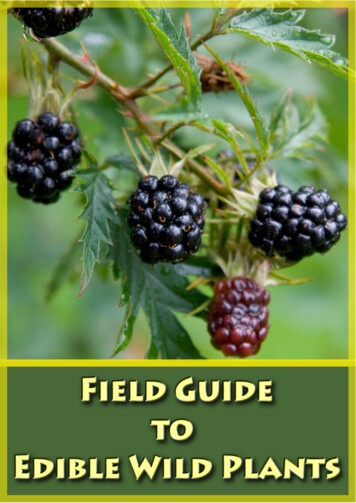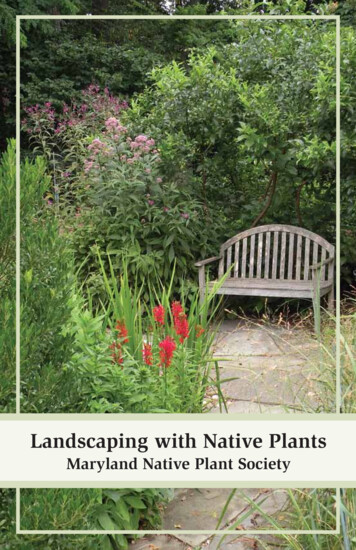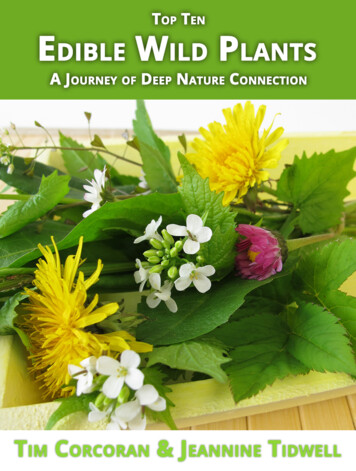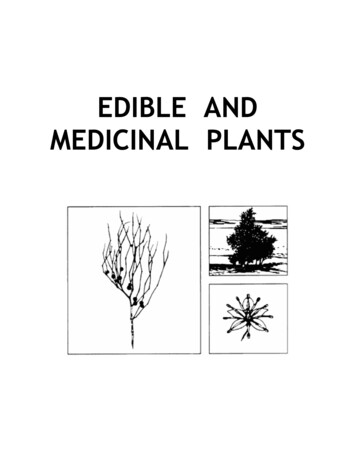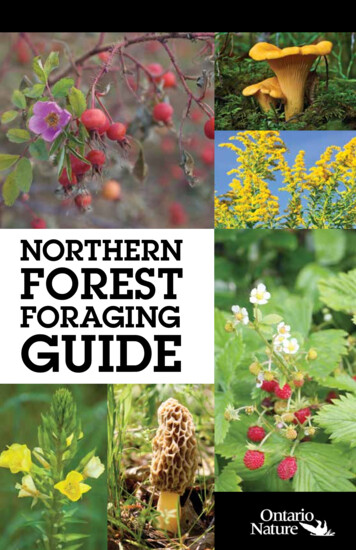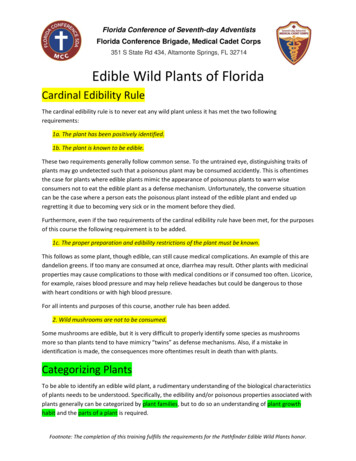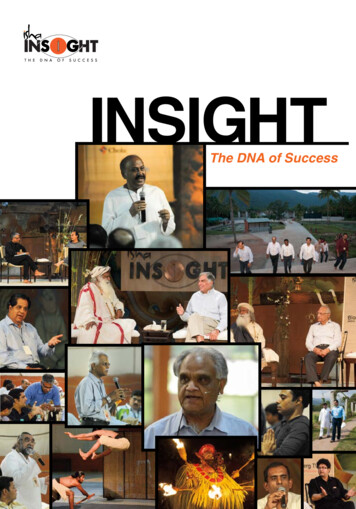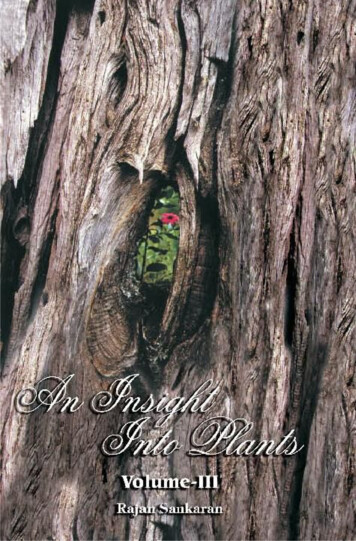
Transcription
An Insight Into Plants
AN INSIGHTINTOPLANTSVolume IIIbyRAJAN SANKARANHOMOEOPATHIC MEDICAL PUBLISHERS201, Dinar, 20, Station Road, Santa Cruz (W), Mumbai - 400 054, India
Dr. Rajan SankaranAll rights reserved. No part of this publication may be reproduced,transmitted or translated into any language in India or abroad in anyform or by any means without permission of the publisher.Printed in IndiaFirst Edition: January 2007ISBN-81-903378-4-xCover photographFrom ‘Epirus’ with the permission of the publisher.Printed byArun K. Mehta at Vakil & Sons Pvt. Ltd.,Industry Manor, Appasaheb Marathe Marg, Prabhadevi, Mumbai 400 025.Published byHOMOEOPATHIC MEDICAL PUBLISHERS201, Dinar, 20, Station Road, Santacruz (W), Mumbai - 400 054, IndiaE-mail : spirit@vsnl.comWebsite : www.thespiritofhomoeopathy.com
CONTENTSVOLUME IIIPageAcknowledgements1011List of Contributors1013Introduction1019A Query and its Clarification1021Notes to the Reader1041PART-IFAMILIES 1 TO 21 FROM VOLUMES I & IISummary, Additions and Illustrative Cases(1) Anacardiaceae1045(2) Berberidaceae1063(3) Cactaceae1065(4) Compositae / Asteraceae1117(5) Conifers1147(6) Euphorbiaceae1193(7) Hamamelididae1217(8) Labiatae / Lamiaceae1247(9) Leguminosae / Fabaceae1265(10) Liliiflorae / Liliidae1289(11) Loganiaceae1309(12) Magnolianae1319(13) Malvales1359
An Insight Into PlantsPage(14) Papaveraceae1367(15) Primulaceae1383(16) Ranunculaceae1391(17) Rubiaceae1433(18) Scrophulariaceae1437(19) Solanaceae1445(20) Umbelliferae / Apiaceae1461(21) Violales1495PART-II – NEW FAMILIESDerivation of Vital Sensation, Miasms and Illustrative cases,Differentiations and Source Words(22) Brassicaceae/Cruciferae1507(23) Carnivorous plants1537(24) Dioscoreaceae1637(25) Fungi (Kingdom)1657(26) Piperaceae1701(27) Rosaceae1741(28) Rutaceae1815PART-III – APPENDICESPlant Families: Differentiations1845Difference Between Sensation and Miasm1850Table of Plant Sensations1851Table of Miasms and Remedies1862Jörg Wichmann’s Chart of Plant Classification1864Index1873
AcknowledgmentsI wish to gratefully acknowledge the contribution of my colleagues in thewriting of this volume.Dr. Urvi Chauhan has been instrumental in putting the book togetherand getting the cases and artwork. Her dedication and inquiring mindhave been a most useful asset in the making of this book.Dr. Meenakshi Vaidya, Botanist, gave valuable expert advice on the plantfamilies.Initial editing was ably done by Dr. Leena Sanghvi. Dr. AbhijeetNanawati and Dr. Sneha Patel made the final corrections.We were fortunate to have the critical comments and, later, most valuableeditorial help from Ms. Julia Schiller. Corresponding with her helped a lotin refining the matter.Thanks a lot to Jörg Wichmann, whose work on classification has been agreat help.Many thanks to my colleagues from all over the world who sent theircases and provings, which we have incorporated in the book. These havehelped confirm and add dimensions to several remedies of the earliervolumes and of the present one.Thanks to Vikas Suri of Goodwin Graphics for doing such a good job withthe artwork in the book.
LIST OF CONTRIBUTORSAlize TimmermanAlize Timmerman has been in homoeopathic practice since 1980 andbegan teaching in 1986. She established the Hahnemann Institute of theNetherlands in 1988. Since 1992, Alize has lectured and taughtthroughout Scandinavia, the European Union, North America, Australia,New Zealand, South Africa and Israel. She works closely with otherteachers, including Jeremy Sherr, Jan Scholten, Corrie Hiwat andAlphons Geukens.Andreas Holling, M.D.Andreas Holling has been in practice in Münster, Germany since 1986,having learnt with Künzli, J.Becker, Vithoulkas, and J.Shah.He has been applying the new method since 2001 and teaching it since2002 in Münster and Münich.Anne SchaddeAnne Schadde has been practicing Homoeopathy since 1984 in Münich,Germany. She gives seminars in Germany, Switzerland, the US,Australia, and New Zealand. Publications of her provings include: Ozonein 1997 and Listening to Stone, Wood and Shell in 2004.Bart Lambert, M.D.Bart has been practicing since 1990 at Kortrijk, Belgium. He is a member of“Samosa”, a Belgian study group. He organizes the Western EuropeanClinical Seminars (four so far) and also teaches a group of French-speakingBelgian colleagues. He enjoys Homoeopathy, Athletics and Jazz music.Bert Lefevre, M.D.Bert Lefevre, now in Antwerp, Belgium, has been practicingHomoeopathy since 1993. He teaches at the V.S.U. Homeopathy School of
An Insight Into PlantsBelgium and is also a guest lecturer at the S.H.O. School of Homeopathyin Holland. He is a founding member of the “Samosa” study group andhas been organizing Homoeopathic seminars since 2002. His website:www.homeopathy-antwerpen.beDivya Chhabra, B.H.M.S.Divya Chhabra is admired for her “circle theory”, use of free associationin Homoeopathy and her work on the effects of different potencies. Herkeenness and practice in taking and solving cases makes her a popularinternational teacher.Deborah L. Gordon, M.D.Deborah L. Gordon lives in Ashland, Oregon, where she has practicedHomoeopathy for 15 years. She has trained at the Hahnemann College ofHomeopathy and taught there for ten years. She has also contributed toLinks and has taught locally and at National Center for HomeopathyAnnual Conference, as well as done radio interviews.Deborah Collins, M.D.Deborah Collins was born in Canada, studied medicine and Homoeopathyin Holland, and now lives and works in New Zealand. She has beenpracticing Homeopathy since 1985. Since the nineties she has lecturedinternationally. She often publishes in Homoeopathic Links.Gajanan Dhanipkar, D.H.M.S.He has been practicing Homoeopathy for nine years at Thane andAmbernath, India. He is presently pursuing post graduate studies in thesubject of the Homoeopathic repertory.Ingrid Van de Vel, M.D.Ingrid Van de Vel is from Belgium. She started studying Homoeopathy in1998 at VSU and in 1999 started her practice in the center of Dr. LeonScheepers, where she is still working. Since 2001 she has been organizingmy video seminars along with Bert Lefevre. She was instrumental inorganizing my “live seminar” in 2005 in Belgium.Jeff Baker, ND, DHANPJeff Baker has been practicing since 1981. For Jeff, Homoeopathy isboth a profession and an adventure. In 1990 he and his wife Susie
List of Contributorscreated the Maui Academy of Homeopathy in order to offer advancedclinical training. Under Jeff’s direction, the goal of the Maui Academycontinues to be to help homoeopaths improve upon their perceptionand practice.Julie Geraghty, M.D.Julie Geraghty has been practicing classical Homoeopathy for 12 years.She lives in Bristol and practices privately and at the BristolHomeopathic Hospital. She also teaches widely in the UK, as well as givesseminars in Europe and Moscow.Joanne GreenlandJoanne Greenland is a homoeopath working for 10 years in Jindivick,Victoria, Australia. She lectures at the Victorian College of Homeopathyin Mitcham, Victoria. She has learned from various teachers. She iswriting a book about the meaning of disease, which she hopes to completesome time in 2006.Jörg Wichmann, M.D.Jörg Wichmann has been practicing Homeopathy for 12 years nearCologne, Germany. Dr. Wichmann has also spent several years lecturingand running a homoeopathic school. Prior to his Homoeopathic career,Dr. Wichmann lectured and wrote as an historian. Information abouthis published works and other projects is available on his website:www.homoeopathie-wichmann.de.Judyth Reichenberg-Ullman, ND, LCSWJudyth is the author or co-author of seven books on Homoeopathyincluding the best-selling Ritalin-Free Kids. She has been practicing since1984 at the Northwest Center for Homeopathic Medicine in Edmonds,Washington. US. Her website is www.healthyhomeopathy.com.Laurie DackLaurie Dack enjoys a full time Homoeopathic practice in Vancouver,Canada. Her study and practice of Homoeopathy have taken her toEurope, India and the U.S. over the past 19 years. She now teaches inCanada and the U.S.
An Insight Into PlantsLinda Johnston, M.D.Linda Johnston graduated from the University of Washington MedicalSchool in 1979, and began practicing medicine in Los Angeles in 1981.Her Homoeopathic practice commenced five years later. Dr. Johnston isthe author of Everyday Miracles: Homeopathy in Action and numerousother articles, in addition to giving lectures, interviews and casepresentations.Mary Gillies, M.D.Mary Gillies became interested in Homoeopathy in 1990, studying at theGlasgow Homeopathic Hospital, and now uses Homoeopathy extensivelyin her NHS practice. She works as a General Physician Homoeopath inrural Scotland. She has attended several seminars in Mumbai and findsher practice of Homoeopathy continues to open and evolve in the light ofthese new understandings.Nandita Shah, L.C.E.H.Practicing Homoeopathy at Quiet Healing Center in Auroville (nearPondicherry, India). Nandita Shah has been actively involved in teachingHomoeopathy in India (since 1983) and abroad (since 1991). Besidespursuing Homoeopathy, she aspires to raise awareness about how eachone can take active responsibility for one’s own well-being through ahealthy diet and an ecologically sustainable lifestyle taking into accountthe interconnectedness of all life forms on the planet.Nancy Herrick, MA, PANancy Herrick has been practicing Homoeopathy since 1975. Director ofthe new Hahnemann Medical Clinic, she also teaches classicalhomoeopathy to professional medical practitioners at Hahnemann Collegeof Homeopathy. She has also been lecturing throughout Europe, Asia,Australia, New Zealand and the USA for twenty years. She is the authorof two books on proving: “Sacred Plants, Human Voices” and ntactjaffemarks@yahoo.comPeter Stevens, M.D.Peter Stevens is from Hamburg, Germany. He has been involved withHomoeopathy since 1985, learning from Ananda Zaren, C.J. Müller, and
List of Contributorsthe Bombay school. He has been teaching since 1999 and giving seminarssince 2002.Rina Markovits, M.D.Rina Markovits is an eminent Homoeopath from Israel. She heads aschool of Homeopathy there besides teaching regularly in Russia.Roger Morrison, M.D.Roger Morrison began the study of Homoeopathy in 1978 under thedirection of George Vithoulkas. In 1985 he was a co-founder of theHahnemann College of Homeopathy in Berkeley, California. His booksinclude: Desktop Guide to Keynotes and Confirmatory Symptoms,Desktop Companion to Physical Pathology, Carbon: Organic Compoundsand Hydrocarbon Remedies in Homeopathy.Richard Moskowitz, M. D.Richard Moskowitz lives and works in Boston, Massachusetts. He haspracticed classical Homoeopathy since 1974. Has given seminars inCalifornia, New York, Arizona, Colorado, Florida, and Ohio and haslectured at annual conferences of LIGA and the Society of Homeopaths(UK, Ireland). He is also, a member of NCH, AIH, LIGA. The books:Resonance: The Homeopathic Point of View and Homeopathic Medicinesfor Pregnancy and Childbirth are among Dr. Moskowitz’s publications.Sunil Anand, L.C.E.H.Sunil Anand is best known for his keen observation and unique approachin the normally difficult area of pediatric cases. He has recently re-locatedto the city of Pune where he practices, teaches at the D.S. HomoeopathicMedical College and heads a clinic in Pediatrics in Homoeopathy.Sudhir Baldota, B.H.M.S.Sudhir Baldota is a teacher of international repute, best known for hiscase taking process.Sujit Chatterjee, D.H.M.S.Sujit Chatterjee has been practicing Homoeopathy since 1983. He is oneof the core teachers of the Bombay School of Homoeopathy. He has alsoused 50 millesimal potency brilliantly in his practice and conductedprovings of remedies like Uranium nitrate, Ficus religiosa, Ficus indica,
An Insight Into Plantsand Chocolate. Dr. Chatterjee has given several international seminars incountries including the USA, Canada, Switzerland, Austria, Germany,and the UK.Sonja MacoughSonja Macough graduated from the School of Classical Homoeopathy inHamburg, Germany, in the spring of 2002. She has been practicing foralmost four years.Urvi Chauhan, B.H.M.S.Combination approach of Homoeopathy along with Yoga has been herasset. Her contributions so far include the present book where she hastransformed Dr. Sankaran’s ideas into this book form, conducts variouscourses and seminars in homoeopathy for national and internationalstudents under the banner of HRC and otherwise along with herhusband. Her website is www.homeohome.com
INTRODUCTIONThe discovery of the sensation level, which is deeper than the delusionlevel, came because that was the only way in which the plant familiescould be understood. The discovery of the seven levels completelyrevolutionized the whole process of taking cases and opened up newhorizons in practice. This has been elucidated in the book The Sensationin Homoeopathy.The earlier two volumes of An Insight Into Plants described twenty-onefamilies with how to come to the common sensation of each family andhow each remedy in a family could be classified into a specific miasm,thus making a kind of grid of the families and miasms enablingpractitioners to choose a remedy. Consequent to the publication of thesevolumes, several colleagues from different parts of the world have appliedthese remedies using this method in their practice with very encouragingresults. They have been sharing their cases with me and these cases alongwith my own have not only helped to confirm the ideas in the earliervolumes but they have also made the understanding of these familiesclearer and more comprehensive. We also could add some more remediesinto the tables thus filling some of the gaps.I felt it would be really worthwhile to bring out these cases along withthe more updated understanding in a book form. Meanwhile, theunderstanding of some other families has been developing and gettingconfirmed in practice. And there was a demand that a third volume ofInsight be brought out with the newer families.The volume that is presently in your hands includes the more updatedunderstanding of the earlier families along with some illustrative cases,especially of rare remedies, from myself and my colleagues as well as newfamilies with their sensations, miasms and illustrative cases. I haveincluded my own comments for many of these cases. I have also included“Alert words” / “Source words” for all families including the families fromthe previous volumes. These words are very useful in practice.
An Insight Into PlantsAt the end of the book, I have included a table of all the families withtheir Sensation, Active reactions, Passive reactions, and Compensation;there is also a Miasms and Remedies table.A new reader is strongly advised to read the books The Sensation inHomoeopathy and An Insight Into Plants Volumes I and II beforeembarking on this volume in order to have a sound foundation in this newmethodology.I have noticed that many beginners and even some experiencedpractitioners tend to read only the tables and not the text. I must strictlywarn that this is very risky. Understanding of an experience cannot comeby merely reading some discrete words. The words are very useful butcannot by themselves convey the whole experience—its context and howit can manifest in people. That can only happen when you read the actualtext, the derivation, the quotations from materia medica and cases. It isthen that you know clearly what the experience is and you are ableto identify it in your patients and also differentiate it from similarsensations.Without this groundwork, merely looking at the tables and prescribing isoften a recipe for failure. It is for this reason that volumes I and II andnow volume III have been written.Only after reading these and absorbing them, can the tables be veryuseful and effective.
A QUERY AND ITS CLARIFICATIONIn 2005 Homoeopathic Links published an article by Julia Schillerentitled, “An Insight Into Taxonomy: A Companion to Sankaran’s ‘AnInsight Into Plants’.I thought this book is the best platform to address the queries putforward since I feel this topic is of interest to all the readers of the Insightseries. Hence I begin by reprinting Julia’s article from HomoeopathicLinks, Volume 18 (4/05), which is then followed by my comments.Interestingly, while I was in the process of addressing Julia’s queries,I sent her a draft of my comments to which she again responded.I personally thank Julia for all her suggestions so far and also print whatJulia had to say in response to my comments.AN INSIGHT INTO TAXONOMYA Companion to Sankaran’s ‘An Insight into Plants’Julia Schiller, New ZealandSummaryThis article provides an overview of plant taxonomy with other analysisand commentary to enable readers to make better use of theinformation in Rajan Sankaran’s ‘Insight into Plants’, published in2002. Sankaran has made a convincing case that the taxon called thefamily is relevant from the homeopathic perspective since patientsneeding plant remedies from the same family share commonsensations. Most of Sankaran’s groupings are supported bycontemporary botanical classification, but five of the groupings areproblematic from the taxonomic viewpoint, probably because he hasrelied on outdated sources to draw them together. His Conifers,Violales, Hamamelidae, Magnolianae, and Liliiflorae groupings, whichare composed of plants sharing higher taxa in common than thebotanical family, are shown to have overlap, potentially prematuregeneralization and/or other problems. Continued work is encouraged toaddress these shortcomings.KEYWORDS: Plant taxonomy, Sankaran’s Insight, Vital sensation.
An Insight Into PlantsIntroduction‘An Insight Into Plants’, published by Rajan Sankaran in 2002, is alreadyproving a useful and exciting work that enables homeopaths to prescribea wider range of plant remedies and to prescribe plant remedies withmore accuracy.Sankaran convincingly demonstrates that the botanical classifications ofplants do have relevance for homeopaths. Specifically, patients needingremedies from plants sharing the same family taxon are likely toexperience similar physical and mental sensations, for exampleconstriction on the part of the Cactaceae or vexation on the part of theRanunculaceae.Some of the remedy plants have been grouped together at a higher taxonthan the family. For several different reasons, including the planttaxonomy on which the work relies, five of these groupings areproblematic. Because the work lacks an overview of taxonomy in generaland proper disclaimers regarding some of these specific groupings, it canbe difficult for an uninformed reader to judge which family pictures mustbe considered more tentative at this stage. There are also smallermistakes and omissions that need to be brought to light.It is important, and I am sure Sankaran would agree, to regard ‘AnInsight Into Plants’ as a work in progress and not as received wisdom. Myaim in writing this article is to help fellow homeopaths to better wieldand refine this important new tool.An Overview of Plant Taxonomy and EvolutionScientists allot all known living things a unique two-part name made upof the genus followed by the species, for example: Ginkgo biloba. Thisscientific name, in Latin or Latinized words, allows internationalresearchers a common and accurate point of reference. Traditionally, inaddition to the binomial name, a species must be slotted into five othertaxa. In order of increasing exclusivity, they are the kingdom, division orphylum, class, order and family. To make finer distinctions whenclassifying, botanists can use intermediate taxa such as the suborderor tribe.Taxonomy changes over time to better reflect the evolutionaryrelatedness of species. For example, two plant species which only sharemembership in the plant kingdom have a much more distant commonancestor than two which are classed in the same order. Molecular and
A Query and its Clarificationgenetic analysis now allows scientists to judge relatedness much morereliably than in the past, when morphology and distribution, which haveoften proven misleading, were the main tools of the taxonomic trade.The International Code of Botanical Nomenclature governs the wayplants are given their scientific names. According to the code, the officialstart of modern plant taxonomy occurred in 1753 with the publication of‘Species Plantarum’ by Carolus Linnaeus. The International Associationfor Plant Taxonomy maintains the code and holds periodic congresses toadopt revisions. The most recent version of the code, the ‘St Louis code’,was adopted in 1999.In the classical naming scheme, the endings of plant taxa are inconsistent.There is now a push for botanists worldwide to adopt the modern namingscheme, which always uses the suffixes listed in Table 1.Table 1: Modern Taxonomic Suffixes for �ophytina–idea–anae–ineae–oideae–eaeA contemporary botanical taxonomic system involves seven divisions ofliving plants: Bryophyta, Lycopodiophyta, Equisetophyta, Psilotophyta,Polypodiophyta, Pinophyta and Magnoliophyta. Very few homeopathicremedies come from the first five divisions, possibly because it is thelatter three that make up the dominant vegetation on Earth today. Infact, the flowering plants (Magnoliophyta) alone make up 80% of all livingplants. With the exception of the Conifers chapter, all of the groupsdepicted in ‘Insight’ are flowering plants.The Magnoliophyta are the familiar plants most often cultivated byhumans for food, fibre, wood products and flowers. In the past, the firststep in classifying this group had sometimes been to consider whether agiven species was monocotyledonous or dicotyledonous (possessing one or
Note to the Reader(1) The placement of remedies within their respective families and theirhigher taxonomical classifications have come from: Wichmann and Bolte’s Natural Relationship of Remedies (whichfollows Arthur Cronquist’s taxonomical classification system) Mac Repertory(2) Chapters for the newer families follow the following pattern ofpresentation: Introduction to the family Derivation of vital sensation Derivation of miasm and vital sensation of each remedy alongwith illustrative cases Summary of sensation and miasm Notes on differentiation from other families Source words/alert words for the family(3) We have made additions to the miasm versus remedies charts in someof the chapters. When the presence of a certain drug is doubtful, owingperhaps to limited cured cases, we have indicated this uncertaintywith a ‘?’ in front of the drug’s name. For example, see Carduusmarianus in the Compositae chapter as well as in the ‘Table of miasmand remedies’ at the end of the book.(4) Abbreviations used in case interviews:D:Doctor/HomoeopathP:PatientMo: MotherFa:Father
An Insight Into Plants(5) Italics in the chapters are used to highlight pertinent phrases.(6) Cases where the homoeopath’s name is not mentioned come from myown practice.(7) To convey my thought processes to the reader, some of the caseshave a “Comment” at the end.(8) All dates mentioned in the case interviews are in the format:dd.mm.yy.
AnacardiaceaePART IFAMILIES FROM VOL. I & II(Summary, Additions, Illustrative Cases)1043
AnacardiaceaeAlso known as the cashew family, the Anacardiaceaeincludes the genera Rhus (sumac), Anacardium, andMangifera. Plants such as poison ivy, poison sumac,and poison oak which cause contact allergies from their milkyirritating juice are all in this family, but oddly enough so are theplants from which we get some delicious foods. Economicallyimportant species includes Anacardium occidentalis (CashewNut), Mangifera indica (Mango) and Pistacia Vera (PistachioNut). This family also gives us the garden ornamental plantCotinus coggygria (Smoke Tree).Summary Anacardiaceae:SensationCaught, Stiff, Tight, Tension, Stuck, Cramps, Pressing, Notallowed to move, Restricted.Passive reactionsParalyzed, Immobile.Active reactionsStuck, wants to move constantly, Motion ameliorates,Aggravation from sitting, Sedentary aggravates, Aggravation inthe house, Pain on beginning to move, Restlessness.CompensationAlways on the move.MIASMSAcuteTyphoidRhus toxicodendronMalariaRhus radicansRingwormRhus venenata1045
An Insight Into PlantsSycoticTubercularCancerLeprosyMangifera indicaAnacardium orientaleComocladia dentata,Rhus glabraSyphiliticSource Words of Anacardiaceae:Caught, catch, grasp, grab, hold, hold of, wedged, trap, get trapped in,clasped in a vice, seize, snare, ensnare, capture, stuck, get stuck, blocked,stuck fast, lodged, clutch, entrapped, anchored, clung, stiff, stiffness,rigid, tight, tightness, tension, taut, inelastic, jammed, like a starch,confining, ironclad, firm, inflexible, unbending, unbendable, unyielding,stretched, firm, constricted, pact, compact, stretching tightly, limitation,strain, sprain, freezes, cramp, cramped, pressure, restrict, limit, constrict,immobile, unmoving, paralyze, motionless, cannot move, lack ofmovement, stationary, at a halt, at a standstill, inactive, unfeeling, inert,static, breezeless, stock-still, still, stunned, as if dead, free, motionameliorates, movable, freed, unchained, untied, liberated, unbound,boundless, release, limitless, uncontrolled, uninhibited, flowing, loose.CASES:RHUS RADICANS CASEItalics are used to highlight the pertinent phrases of the case.CASE OF AUTOIMMUNE HEPATITISA forty-one year old woman first consulted me on 3/07/2002 for autoimmunehepatitis for which a liver transplant had been advised.I asked her to tell me what her complaints were.“I am feeling weak, giddy. I used to vomit when I had jaundice and stomach ache.I don’t feel like eating.”D:P:What effect does this problem have on you?Tension because of the liver transplant. I am worried because everyone saysthat the liver is damaged. I am worried about the family.1046
BerberidaceaeBerberidaceae, also known as the barberry family,includes Podophyllum, Caulophyllum, and Berberisvulgaris as commonly used homoeopathic remedies.Certain plants like Berberis repens bear edible fruits that areconsumed raw or cooked and are also used to make jams, jelliesand refreshing lemonade-like beverages. When combined withsugar, the juice of these fruits makes a flavor similar to grapejuice. Berberidaceae grow in shrub or herb form.Summary of Berberidaceae:SensationSudden, intense, rapid changeability at the mental as well as thephysical level.Passive reactionsConfusion; Dullness; Prostration of mind; Confusion of identity;Confusion from interruption.Active reactionsRapid change of location and character.CompensationEasily adaptable to changing situation; Able to change quicklyaccording to the situation.MIASMSAcuteTyphoidPodophyllum peltatumMalariaBerberis 63
An Insight Into PlantsTubercularCancerLeprosySyphiliticBerberis aquifoliumSource words of Berberidaceae:Sudden change, intense change, rapid change, shift, suddentransformation, sudden alteration, sudden revolution, suddenmodification, sudden variation, unpredictable, erratic, budge, uncertainty,modification, variation, conversion, adjustment, unsettled, unreliable,unstable, unfixed, swing, undependable, fluctuate, oscillate, ebb and flow,inconsistent, irregular, vacillate, capriciousness, fickleness, difference,certainty, sureness, surely, for sure, absolute, constant, persistent, steady,stable, certitude.1064
CactaceaeThe cactus plant family includes the prominenthomoeopathic remedies Cactus grandiflorus, Cereusbonplandii, and Anhalonium that have often provedremarkable in the face of heart ailments. These plants are wellknown for their succulent stems, spines (which are actuallyreduced leaves) and colourful flowers.Summary of Cactaceae:SensationConstricted, Made smaller, Shrunken. Contracted, Bound,Trapped, Pressed, Downtrodden, Oppressed, Weighed down,Clutched.Passive reactionShrunken.Active reactionsExpansion, Becoming bigger, boundless and released.CompensationNot affected by contraction and oppression.MIASMSAcuteCactinaTyphoidCarnegia giganteaMalariaCactus grandiflorusRingwormOpuntia vulgarisSycoticTubercularCereus bonplandiiCancerAnhalonium lewiniiLeprosyCereus serpentinusSyphilitic1065
An Insight Into PlantsSource Words of Cactaceae:Constricted, constrict, contracted, made smaller, shrunken, shrink,trapped, pressed, clutched, clutch, weighed down, oppressed, press,pressure, downtrodden, bound, cram, pack, tight, pack together, grasp,clasp, grab, grip, compact, tighten, force down, compress, squeeze,constrain, condense, get smaller, grow smaller, trapped, entrapped,caught, entangled, snared, ensnared, webbed, clamping, stranded, shrivel,bracing, confined, expansion, expand, boundless, released, unlimited,endless, limitless, infinite, ceaseless, never ending, illimitable, vast,without end, spreading out, get bigger, make bigger, becoming bigger,growing big, huge.CASES:CACTINA CASE 1By Jeff BakerItalics are mine.The following case is one that some will find controversial since, to myknowledge, there is virtually no information about the remedy that was employedin the case in the existing Homeopathic literature. Some so-called purists find itvery disturbing to hear that remedies are being given despite their not beingproven.In Aphorism 3 of The Organon of Medicine, Dr. Hahnemann states “if thephysician clearly perceives what is curative in medicines, that is to say, in eachindividual medicine (knowledge of medicinal powers), and if he knows how toadapt according to clearly defined principles what is curative in medicines to whathe has discovered to be undoubtedly morbid in the patient, so that the recoverymust ensue. then he understands how to treat judiciously and rationally, and heis a true practition
Judyth is the author or co-author of seven books on Homoeopathy including the best-selling Ritalin-Free Kids. She has been practicing since 1984 at the Northwest Center for Homeopathic Medicine in Edmonds, Washington. US. Her website is www.healthyhomeopathy.com. Laurie Dack Laurie Dack enjoys a full time
